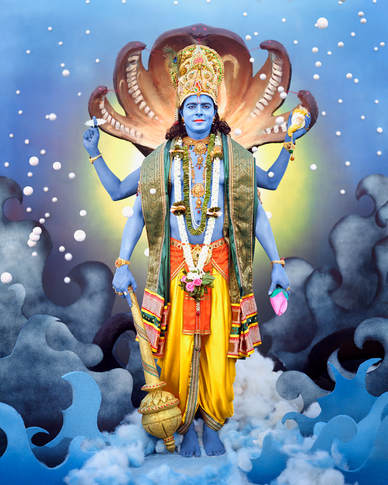|
The Bhagavad Gita – the Dhyan or Raja or Kriya Yoga (राज योग / ध्यान योग) ॥ श्रीमद्भगवद्गीता ॥ ॥ ॐ श्री परमात्मने नमः ॥ ॥ अथ श्रीमद्भगवद्गीता ॥ Shree Krishna in Shrimad Bhagavad Gita has showed four paths of liberation viz. the karma yoga, the jnana yoga, the bhakti yoga and the dhayan or raja yoga. Path of Raja yoga is explained in chapters 6 and 8. The Raja Yoga is the conquering of the internal organs (mind, intellect and ego) by psychic control. Shree Krishna says, the Raja Yogi is superior to the ascetic (तपस्वी); he is regarded superior even to the persons who have knowledge of scriptures. The Yogi is also superior to those who perform action with some interested motive (6.45). Shree Krishna has explained that the Raja yogi should practise moderation in his daily habits—in eating; sleeping, recreation, etc.; practise meditation by sitting in a comfortable posture, with the head; neck and spine erect (not tensed) and fix his purified & unwavering mind on the Atman by concentrating between the eyebrows or on the tip of the nose. By regular meditation upon the Atman, Raja yogi gradually transcends the senses and intellect and merges himself in the blissful Atman. He finds that the bliss of the Atman is incomparable, that there is no gain greater than the Self. Having thus attained perfect union with the Self, the Yogi no more descends into ignorance or delusion. He does not relish any more the pleasures of the senses and once the yogi is well established in the Brahman i.e. state of bliss from which, even the greatest sorrow cannot shake him. Self-centredness goes away. This ultimately leads to the vision of the Lord in all beings and creatures. Shree Krishna assures that the practice can succeed through Vairagya (dispassion), regular practice, intense faith & devotion and strong aspiration for ascending in spiritual life. He assures Arjuna that the accumulated power of his Yogic practices will assure him a better birth in the future, with more favourable conditions for Sadhana. The detailed explanations, chapter wise and verse-wise are as under (the relevant Sanskrit verses of Bhagavad Gita are mentioned at the bottom): Who can do Meditation: The person, who has controlled his mind and body, is free from desires and void of possessions, live in seclusion and constantly engage his mind in meditation (6.10). How to do Meditation:
Precautions to do Meditation:
State of Mind of accomplished Raja Yogi:
Goal attained by Raja Yogi:
Re-birth of Raja Yogi:
Reference:
Chapter: 6 योगी युञ्जीत सततमात्मानं रहसि स्थितः । एकाकी यतचित्तात्मा निराशीरपरिग्रहः ॥ ६-१०॥ शुचौ देशे प्रतिष्ठाप्य स्थिरमासनमात्मनः । नात्युच्छ्रितं नातिनीचं चैलाजिनकुशोत्तरम् ॥ ६-११॥ तत्रैकाग्रं मनः कृत्वा यतचित्तेन्द्रियक्रियः । उपविश्यासने युञ्ज्याद्योगमात्मविशुद्धये ॥ ६-१२॥ समं कायशिरोग्रीवं धारयन्नचलं स्थिरः । सम्प्रेक्ष्य नासिकाग्रं स्वं दिशश्चानवलोकयन् ॥ ६-१३॥ प्रशान्तात्मा विगतभीर्ब्रह्मचारिव्रते स्थितः । मनः संयम्य मच्चित्तो युक्त आसीत मत्परः ॥ ६-१४॥ युञ्जन्नेवं सदात्मानं योगी नियतमानसः । शान्तिं निर्वाणपरमां मत्संस्थामधिगच्छति ॥ ६-१५॥ नात्यश्नतस्तु योगोऽस्ति न चैकान्तमनश्नतः । न चातिस्वप्नशीलस्य जाग्रतो नैव चार्जुन ॥ ६-१६॥ युक्ताहारविहारस्य युक्तचेष्टस्य कर्मसु । युक्तस्वप्नावबोधस्य योगो भवति दुःखहा ॥ ६-१७॥ यदा विनियतं चित्तमात्मन्येवावतिष्ठते । निःस्पृहः सर्वकामेभ्यो युक्त इत्युच्यते तदा ॥ ६-१८॥ यथा दीपो निवातस्थो नेङ्गते सोपमा स्मृता । योगिनो यतचित्तस्य युञ्जतो योगमात्मनः ॥ ६-१९॥ यत्रोपरमते चित्तं निरुद्धं योगसेवया । यत्र चैवात्मनात्मानं पश्यन्नात्मनि तुष्यति ॥ ६-२०॥ सुखमात्यन्तिकं यत्तद् बुद्धिग्राह्यमतीन्द्रियम् । वेत्ति यत्र न चैवायं स्थितश्चलति तत्त्वतः ॥ ६-२१॥ यं लब्ध्वा चापरं लाभं मन्यते नाधिकं ततः । यस्मिन्स्थितो न दुःखेन गुरुणापि विचाल्यते ॥ ६-२२॥ तं विद्याद् दुःखसंयोगवियोगं योगसंज्ञितम् । स निश्चयेन योक्तव्यो योगोऽनिर्विण्णचेतसा ॥ ६-२३॥ सङ्कल्पप्रभवान्कामांस्त्यक्त्वा सर्वानशेषतः । मनसैवेन्द्रियग्रामं विनियम्य समन्ततः ॥ ६-२४॥ शनैः शनैरुपरमेद् बुद्ध्या धृतिगृहीतया । आत्मसंस्थं मनः कृत्वा न किञ्चिदपि चिन्तयेत् ॥ ६-२५॥ प्रशान्तमनसं ह्येनं योगिनं सुखमुत्तमम् । उपैति शान्तरजसं ब्रह्मभूतमकल्मषम् ॥ ६-२७॥ सर्वभूतस्थमात्मानं सर्वभूतानि चात्मनि । ईक्षते योगयुक्तात्मा सर्वत्र समदर्शनः ॥ ६-२९॥ सर्वभूतस्थितं यो मां भजत्येकत्वमास्थितः । सर्वथा वर्तमानोऽपि स योगी मयि वर्तते ॥ ६-३१॥ चञ्चलं हि मनः कृष्ण प्रमाथि बलवद् दृढम् । तस्याहं निग्रहं मन्ये वायोरिव सुदुष्करम् ॥ ६-३४॥ असंशयं महाबाहो मनो दुर्निग्रहं चलम् । अभ्यासेन तु कौन्तेय वैराग्येण च गृह्यते ॥ ६-३५॥ प्राप्य पुण्यकृतां लोकानुषित्वा शाश्वतीः समाः । शुचीनां श्रीमतां गेहे योगभ्रष्टोऽभिजायते ॥ ६-४१॥ अथवा योगिनामेव कुले भवति धीमताम् । एतद्धि दुर्लभतरं लोके जन्म यदीदृशम् ॥ ६-४२॥ तत्र तं बुद्धिसंयोगं लभते पौर्वदेहिकम् । यतते च ततो भूयः संसिद्धौ कुरुनन्दन ॥ ६-४३॥ प्रयत्नाद्यतमानस्तु योगी संशुद्धकिल्बिषः । अनेकजन्मसंसिद्धस्ततो याति परां गतिम् ॥ ६-४५॥) Chapter: 8 संशयम् अभ्यासयोगयुक्तेन चेतसा नान्यगामिना । परमं पुरुषं दिव्यं याति पार्थानुचिन्तयन् ॥ ८-८॥ प्रयाणकाले मनसाऽचलेन भक्त्या युक्तो योगबलेन चैव । भ्रुवोर्मध्ये प्राणमावेश्य सम्यक् स तं परं पुरुषमुपैति दिव्यम् ॥ ८-१०॥ सर्वद्वाराणि संयम्य मनो हृदि निरुध्य च । मूर्ध्न्याधायात्मनः प्राणमास्थितो योगधारणाम् ॥ ८-१२॥ ओमित्येकाक्षरं ब्रह्म व्याहरन्मामनुस्मरन् । यः प्रयाति त्यजन्देहं स याति परमां गतिम् ॥ ८-१३॥ अनन्यचेताः सततं यो मां स्मरति नित्यशः । तस्याहं सुलभः पार्थ नित्ययुक्तस्य योगिनः ॥ ८-१४॥
0 Comments
Leave a Reply. |

 RSS Feed
RSS Feed